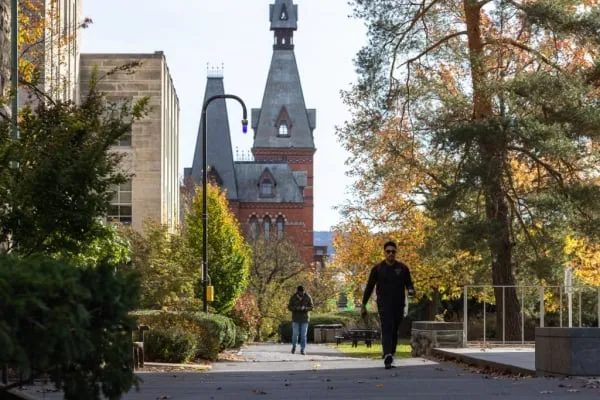With a curriculum that includes slavery, the Civil War, Reconstruction, two world wars and the Civil Rights Movement, American history teachers are used to venturing into emotionally charged subjects. Walking students through the unsettling complexities of the past has never been an easy job. But as history is about to take center stage in 2026 for 250th anniversary celebrations of the nation’s founding, there are growing signs that the work of teaching about the country’s past has become harder than ever.
In a survey last year of more than 3,000 social studies teachers across the country, the American Historical Association found K-12 history teachers are feeling underappreciated and isolated, from a combination of lackluster student engagement — a stubborn holdover from the pandemic — persistent budget cuts that deny them essential professional development, and a frustrating sense that people outside the classroom don’t respect what they do.
According to the report, “American Lesson Plan: Teaching U.S. History in Secondary Schools,” 16 percent of teachers said they received frequent or several criticisms from parents or others over the way they teach history. About 40 percent said they’ve had to respond to such pushback at least once or twice.
Some teachers objected to those numbers, saying they minimize the political stresses many of them are actually experiencing, says Brendan Gillis, the association’s director of teaching and learning, who oversaw the study. He concedes the percentages seem low, but it’s because they reflect only a very narrow focus of what is happening in classrooms, excluding the more widespread peripheral pressures that can hurt teachers indirectly.
“A lot more places have seen efforts to remove books from libraries or to ban certain titles, which have an effect for history teachers, but it’s less focused specifically on what’s happening in history classrooms,” Gillis said. “But, yes, at the end of the day, if more people, more Americans understood what teachers are teaching in history classrooms, they’d have a very different attitude about how to fix some of the problems of public education.”
The AHA’s report came out at the end of 2024, before President Donald Trump took office. Conditions haven’t improved for social studies teachers since. One of Trump’s first executive orders claimed schools use “radical indoctrination” to imprint “anti-American, subversive, harmful, and false ideologies” on children.
Though AHA researchers stress they found no “indoctrination, politicization or deliberate classroom malpractice,” the heavy-handed political rhetoric from the White House harms teachers, says Emma Humphries, a former history teacher and now chief education officer at the civics advocacy group iCivics.
“These are people who went into the profession because they love our country, they love our history, they love our founding ideals, they love our Constitution, and they want to cultivate that same sort of love and attachment in their students,” Humphries says. “That doesn’t mean that they just paint this perfect, rosy picture like we’ve never made mistakes, because, goodness knows, we have as a country our shortcomings and our mistakes. But we’re always striving toward that more perfect union.”
“It’s frustrating and I would even say demoralizing when it feels like the politicians don’t understand that,” Humphries adds.
Painting approaches to history in stark black and white can shut down debate and keep social studies teachers from achieving what 94 percent of them report is the most important part of their job: preparing students for meaningful civic engagement.
“I do think that there are things that teachers stay away from because they are afraid that it will get them into some sort of trouble — and one of the things is current events,” says Samantha Futrell, a middle school social studies teacher in Richmond, Virginia. “We feel so polarized right now.”
Michelle Nystel, who teaches high school social studies in a small district in northeast Iowa, has to work harder lately to keep students from falling into polarized camps: “It is getting less likely that I have kids who are open-minded and not just saying what their family says.”
Sources Under Scrutiny
And polarization now threatens teachers’ primary information sources. Researchers were surprised to learn, Gillis says, that the most-used sources for historical information are not textbooks but online sites run by museums and the federal government, especially the Smithsonian, Library of Congress and National Archives. More than 80 percent of teachers report using information from these government institutions as part of their lessons.
“Textbooks clearly are diminishing in influence,” the AHA report states. Some 32 percent of teachers reported never using one. Textbooks are expensive, cumbersome and need updating, so fewer districts budget for them, Gillis says. Online government sources, on the other hand, are free, up-to-date and trusted to be accurate and nonpartisan.
Or, rather, they were until a few weeks ago. The Trump administration recently targeted government history webpages for revision as part of its campaign against diversity, equity and inclusion. The changes are “quite alarming,” Gillis says.
A March 27 executive order accuses Smithsonian sites, including the American Art Museum and the National Museum of African American History and Culture, of giving a “distorted narrative driven by ideology,” casting the country’s “founding principles and historical milestones in a negative light.” It directs Vice President JD Vance to supervise sweeping rewrites.
In early April, the Washington Post reported that the National Park Service significantly rewrote webpages about the Underground Railroad and abolitionist Harriet Tubman, replacing a detailed account about enslaved African Americans with a shorter description that never mentions slavery.
An earlier Post investigation found that the Defense Department purged online articles about Native Americans who made wartime contributions, including the famous Navajo code talkers of World War II and the Tonawanda Seneca officer who drafted the terms of the Confederacy’s surrender at Appomattox in 1865.
Defense history pages highlighting the contributions of women in the military were among several that were pulled for more than a week to be stripped of any references to diversity.
Though some purged material was later restored, that once-trusted sites can be politicized at all is a chilling prospect for history teachers.
“It’s incapacitating,” says Futrell, who was National Council for the Social Studies teacher of the year in 2024. “We have trained students to see these sites put out by the federal government as really reliable narrators to American history. So when there is involvement from a political perspective into what are supposed to be nonpartisan sources, it becomes very tenuous to use these things in the classroom.”
It isn’t just that teachers have to find new, nonpartisan sources. They now must explain the limitations of compromised sources to their students — a difficult, nuanced discussion that distracts from their main curriculum.
“It creates a lot more work for educators,” Futrell says. “It is basically taking away from our instructional time.”
What’s more, interfering with trusted sources raises deeper questions about authenticity and the merits of study.
“The piece I struggle with as an educator is how do you teach the truth when the truth is all relative?” Nystel asks, “when people in the world can make the truth whatever they want the truth to be?”
Nystel points to the recent scaling back of National Endowment for the Humanities funding as a further blow to good history. She used NEH grants to attend professional development workshops that enhanced her teaching, a significant benefit in a vast state where teachers often have to travel up to six hours round-trip to meet with their peers.
Among the NEH grants canceled was more than $300,000 for National History Day, the annual competition that is the humanities equivalent to a national science fair. The history day foundation plans to continue with this year’s program and launched a fundraising campaign to make up for the lost grant money.
All of these cuts, revisions and political directives about American history cast a long shadow over teachers’ preparations for the country’s 250th anniversary celebrations next year when the spotlight should be on studying our past in all its intricate beauty and flaws, Humphries at iCivics says. Only by doing so can students reflect well on the nation’s founding principles and gain a deeper appreciation for our system of government.
“When you learn history, it builds this sort of greater connection to one’s country,” she adds, “which would lead someone to be more engaged in civic and political life.”


